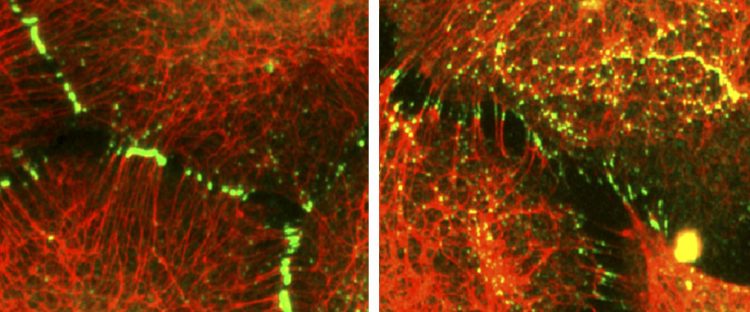Desmoplakin’s Tail Gets the Message

Albrecht et al., 2015 Desmoplakin (green) normally resides at cell-to-cell junctions (left), but in cells that can’t modify it (right), it associates with intermediate filaments (red).
Desmoplakin is a key component of the adhesive junctions, known as desmosomes, that link cells together in tissues that undergo severe strain, such as the heart and skin. Its role is to anchor parts of the cytoskeleton to sites of cell-to-cell contact.
Kathleen Green and colleagues at Northwestern University Feinberg School of Medicine determined how modifying desmoplakin’s intracellular tail with phosphate and methyl groups affects the protein’s interaction with the cytoskeleton.
The enzyme GSK3 added phosphate groups to desmoplakin’s tail, and its loss spurred the protein to shift from desmosomes to the intermediate filaments. Blocking GSK3 slowed desmoplakin’s relocation from the intermediate filaments to the cells’ boundaries during desmosome formation.
Methylation of four arginine residues in desmoplakin’s tail had similar effects as phosphorylation. The team also found that methylation of one particular arginine, R2834, which is mutated in some patients with arrhythmogenic cardiomyopathy, was necessary for the phosphorylation of most tail serine residues because this modification drew GSK3 to desmoplakin. Mutating this arginine delayed desmoplakin’s assembly into desmosomes, weakening intercellular connections so that cell layers broke apart under mechanical stress.
The results show that phosphorylation and methylation make desmoplakin more dynamic. Cells might be able to fine-tune desmoplakin’s characteristics by adding and removing phosphates and methyl groups, and defects in this regulatory process might contribute to skin and heart diseases.
Albrecht, L.V., et al. 2015. J. Cell Biol. doi:10.1083/jcb.201406020
About The Journal of Cell Biology
The Journal of Cell Biology (JCB) is published by The Rockefeller University Press. All editorial decisions on manuscripts submitted are made by active scientists in conjunction with our in-house scientific editors. JCB content is posted to PubMed Central, where it is available to the public for free six months after publication. Authors retain copyright of their published works, and third parties may reuse the content for non-commercial purposes under a creative commons license.
For more information, please visit www.jcb.org .
Contact Information
Rita Sullivan King
Communications Manager
news@rupress.org
Phone: 212-327-8603
Media Contact
All latest news from the category: Life Sciences and Chemistry
Articles and reports from the Life Sciences and chemistry area deal with applied and basic research into modern biology, chemistry and human medicine.
Valuable information can be found on a range of life sciences fields including bacteriology, biochemistry, bionics, bioinformatics, biophysics, biotechnology, genetics, geobotany, human biology, marine biology, microbiology, molecular biology, cellular biology, zoology, bioinorganic chemistry, microchemistry and environmental chemistry.
Newest articles

Silicon Carbide Innovation Alliance to drive industrial-scale semiconductor work
Known for its ability to withstand extreme environments and high voltages, silicon carbide (SiC) is a semiconducting material made up of silicon and carbon atoms arranged into crystals that is…

New SPECT/CT technique shows impressive biomarker identification
…offers increased access for prostate cancer patients. A novel SPECT/CT acquisition method can accurately detect radiopharmaceutical biodistribution in a convenient manner for prostate cancer patients, opening the door for more…

How 3D printers can give robots a soft touch
Soft skin coverings and touch sensors have emerged as a promising feature for robots that are both safer and more intuitive for human interaction, but they are expensive and difficult…





















